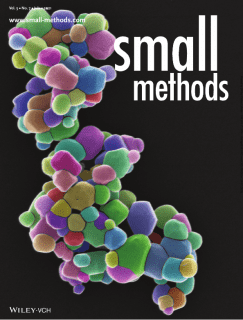Article on the front cover of small methods
Congratulation to Leonid Mill, Tom Wirtz (Luxembourg Institute of Science and Technology), Silke Christiansen (Institut für Nanotechnologie und korrelative Mikroskopie) and Andreas Maier for being featured on the front cover of “Small Methods” with their article “Synthetic Image Rendering Solves Annotation Problem in Deep Learning Nanoparticle Segmentation”. In the context of the highly interdisciplinary research project npSCOPE, that aims for the characterization of nanoparticles, Mill et al. developed a method that solves the data annotation problem for the deep learning-based segmentation of complex nanoparticle agglomerates in helium ion microscopy images. This work paves the way toward automated and high-throughput nanoparticle image analysis for a variety of applications.
Abstract:
Nanoparticles occur in various environments as a consequence of man-made processes, which raises concerns about their impact on the environment and human health. To allow for proper risk assessment, a precise and statistically relevant analysis of particle characteristics (such as size, shape, and composition) is required that would greatly benefit from automated image analysis procedures. While deep learning shows impressive results in object detection tasks, its applicability is limited by the amount of representative, experimentally collected and manually annotated training data. Here, an elegant, flexible, and versatile method to bypass this costly and tedious data acquisition process is presented. It shows that using a rendering software allows to generate realistic, synthetic training data to train a state-of-the art deep neural network. Using this approach, a segmentation accuracy can be derived that is comparable to man-made annotations for toxicologically relevant metal-oxide nanoparticle ensembles which were chosen as examples. The presented study paves the way toward the use of deep learning for automated, high-throughput particle detection in a variety of imaging techniques such as in microscopies and spectroscopies, for a wide range of applications, including the detection of micro- and nanoplastic particles in water and tissue samples.
Acknowledgments:
The research leading to these results has received funding from the European Union’s Horizon 2020 Research and Innovation program (Grant agreement No. 720964) as well as from the European Research Council (ERC) (Grant agreement No. 810316).
Front Cover: https://onlinelibrary.wiley.com/doi/10.1002/smtd.202170028
Article: https://doi.org/10.1002/smtd.202100223
